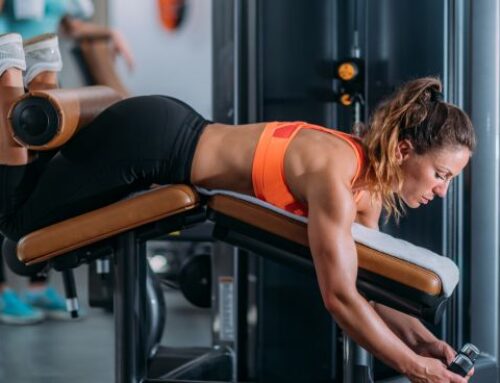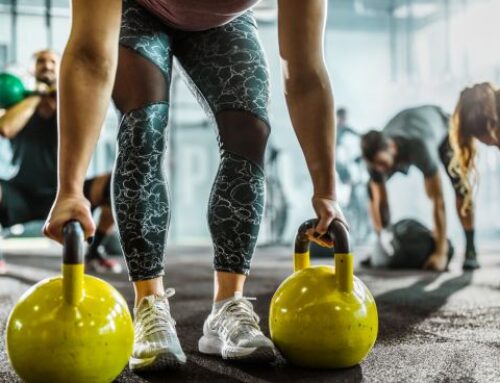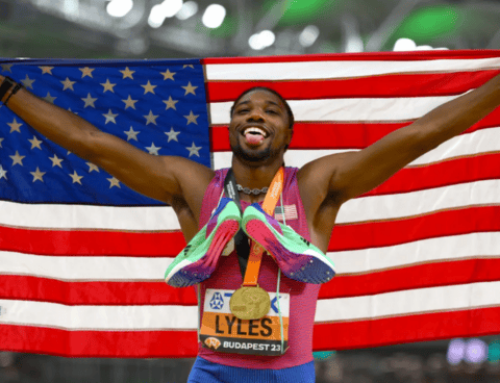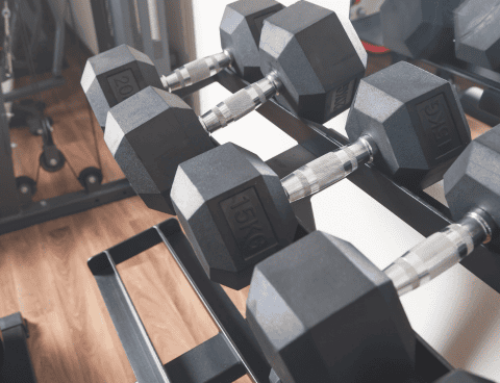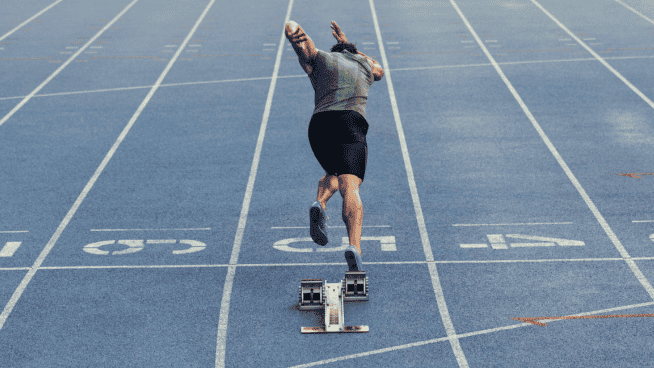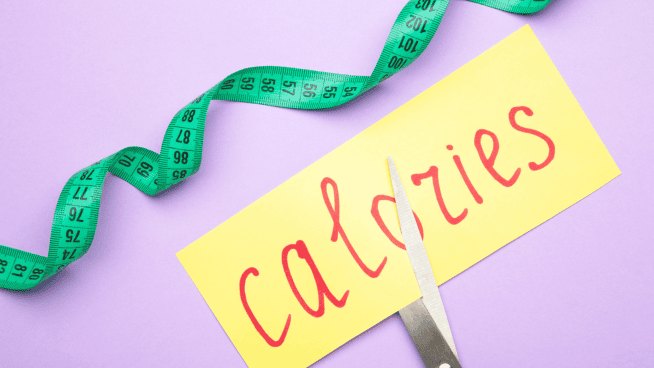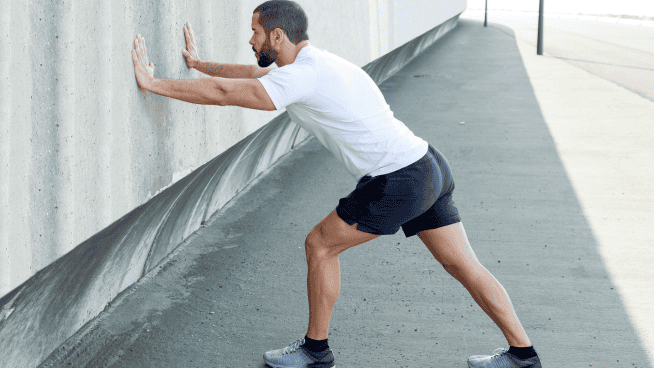5 Strength Training Tips for High School Hockey Players
If you’re a high school hockey player, I’ve got great news for you.
You’re old enough to start lifting weights for real.
You enter the Iron Game because you realize (or your coach blatantly informs you) that you need to get bigger and stronger to compete at a higher level on the ice. But the pursuit of physical excellence will also continue to benefit you long after you hang up your skates.
Most high school hockey players I’ve met are easy to work with and willing to put in the effort to improve. What they often lack is proper guidance.
The problem at the high school level is that having access to quality coaching or training programs is a luxury enjoyed by a small number of athletes.
Many clubs and schools don’t have a strength and conditioning coach on their staff. Those that do typically hire individuals based on connections and how much their budget allows them to spend, not necessarily on merit.
That’s unfortunate because your high school years are a prime opportunity to develop as an athlete both mentally and physically. They’re too important to waste on subpar training. Even if you never intend to play college or professional hockey, trying to figure out this lifting weights thing on your own leads to mediocre or downright poor results. Who wants that?
With that in mind, here are my top five weight room tips for high school hockey players.
1. Pay for Quality Coaching
The quickest, most productive way to see significant results from your gym efforts is hiring a real professional to teach you how to safely perform the main strength movements and to design your training programs.
If there’s one thing I wish I had done differently in my youth athletics career, it’s learning how to lift and train with a purpose instead of going through the usual routine consisting of Bench Presses and arm exercises, interspersed with a few sets of Leg Presses and Leg Curls twice per week. You could say that’s standard stuff for pretty much every teenager who discovers lifting weights, but it’s really not doing much to build full-body strength nor enhance athletic performance.
That was 15 years ago. Yet, when I observe what goes on at public gyms these days, things haven’t changed much. Today’s high school hockey players choose improper exercises and lift with downright disgusting form. On top of that, they rarely train hard or push themselves.
Most don’t follow a proven system or program, instead opting to train by feel every time they step inside the weight room. The few athletes who appear to run some semblance of a training program are either following an outdated approach their hockey coach used back in the 1980’s or a random workout plan they found online.
Quality coaching helps slash the learning curve and accelerate your progress.
I’m not telling you this because I have a vested interest in selling you my coaching or programs. I say this because, after working with hundreds of high school athletes, I can immediately spot an individual who has been coached properly. These athletes move better, pick up new exercises quickly, and rarely get injured on or off the ice. And of course, the longer they have been following solid training principles, the stronger and more physically developed they look.
The physical gap between those who receive quality lifting advice (and subsequently, put that information to good use) versus those who don’t is immense. And it keeps getting wider with every passing month.
A good strength coach will be able to teach you basic proficiency in the main barbell lifts (Bench Press, Squat and Deadlift) within a couple of training sessions.
Yes, that may mean working a few extra shifts at your summer job to cover the coach’s fee. But that’s money well invested. Money that benefits your performance on the ice today and your health and longevity for decades to come. You can’t put a price tag on that.
Does your teammate know some shady dude who’s friends with a fella who trains pro wrestlers? Yeah, he’s probably not the guy you want to work with for off-ice training. But a legit hockey strength coach with a proven track record of producing better hockey players in your area? That’s the guy you should reach out to.
2. Stick to the Basics
At our gym, we have 16-year-old hockey players who can Trap Bar Deadlift 450-plus pounds and perform Chin-Ups with 100 pounds of added resistance.
Granted, some athletes are more gifted than others when it comes to developing physical strength, and comparing your numbers to theirs doesn’t really make much sense.
But I’m mentioning this because none of our hockey players got stronger by accident or by winging it. It was all done with basic, heavy strength work repeated over an adequate time period. Lots of Squatting, Pressing, Rowing and picking up big weights from the floor.
No shortcuts, no gimmicks.
Social media is a key reason why so many athletes fail to reach their potential in the weight room. The constant stream of different exercises and lifting methods that often contradict each other yet somehow seem to be working for the people pushing their own style of training will make your head spin.
What also doesn’t help is that your favorite pro athlete or Instagram fitness star plays on your insecurities and attempts to extract as much cash out of you as possible with offers ranging from six-week transformation programs and online coaching to a paltry 10% off your next purchase of overpriced protein powder through their affiliate link. It gets confusing and you don’t know whom to trust or what to do. Paralysis by analysis sets in.
There’s a time and place for more advanced training methods like drop sets, cluster sets, partial reps, bands/chains and whatnot.
But in your first couple years of lifting, you can’t beat the results that moving moderately heavy to heavy weights over a full range of motion with textbook form will provide. Save the special training tactics and fancy tricks for later down the line when you have built a solid strength base through basic barbell, dumbbell and bodyweight training.
3. Track Your Workouts
Here’s an easy tip that will instantly put you in the top 5% of high school hockey players in the nation: Buy a pen and an empty notebook. Record all your gym sessions in the notebook. That’s it!
The simple act of recording your gym performance increases accountability, motivation and adherence to your program. You’ll get so much more out of your weight room workouts when you have a tracking system in place compared to just winging it like the rest of your buddies do.
Without a log, you won’t remember how much weight you Squatted last week, let alone how many reps you Dumbbell Bench Pressed with the 55-pounders a month ago. And when you have a log, you don’t have to remember these figures, because your notebook does it for you. All you need to do is flip back the pages and look up your previous numbers.
It boggles my mind that so few athletes take advantage of this simple yet super effective habit. A $5 investment for a pen and notebook will pay itself back many, many times over as you continue to gain more strength and muscle.
4. Beat Your Previous Numbers
Now that you’re recording all your training parameters (reps, sets, weights, rest periods, lifting tempo, etc.) in your workout journal, your next objective is to consistently improve the amount of weight you lift or the number of reps you perform. And when I say consistently, I mean more or less on a weekly basis.
Beginner gains are a wonderful thing. I have witnessed high school hockey players who have never lifted before Squat 300-plus pounds and Trap Bar Deadlift 400-plus pounds for reps within four months of starting training.
How? Just by adding a bit more weight to the bar from one week to the next. When you’re just starting to strength train for real, the gains will come fast and furious. Enjoy the magic of beginner gains while you can. You will experience them only once in your life, and the party grinds to a stop sooner than you think.
Note that when I tell you to beat your previous numbers, I don’t advocate doing so at the expense of degrading technique.
Never attempt a weight you’re not confident you can lift with good form. I see teenagers at the gym who look like they can’t Bench even 135 pounds for a set of five load the bar with 220 pounds. Then they get crushed by the weight. The only person experiencing a training effect from that is the spotter who gets a back workout from heaving up the bar off his overzealous friend’s chest.
Also pay attention to the range of motion on your lifts. It’s a common sight in gyms all over the world—as the weights get heavier, Squats get shallower.
Yes, you’re moving more weight than before, but does that mean you got stronger? If you’re cutting range of motion shorter just so you can load up the bar with more resistance, you’re really not increasing strength.
5. Think Five Years Ahead
In my experience, it will take three to five years for a high school hockey player to reach a solid level of physical strength if he cultivates proper lifting, eating and recovery habits. The more gifted you are physically, the less time it will take.
For reference, I started working with one of my NHL draft picks the summer he turned 18. Back then, he was Power Cleaning 110 pounds for 5 reps. Three years later, at 21, he Power Cleans 275 pounds for 5 reps and Trap Bar Deadlifts almost 550 pounds. If you’re lifting such numbers, you can play hockey in any league in the world from a physical strength and power standpoint.
Take the above guideline of 3-5 years and do the math. Even if you’re small and skinny (aka not gifted physically) to begin with, you can still make a drastic change in your performance and appearance through sheer consistency given enough time.
Let’s say you start lifting for real in high school at age 16. If you take the college route, five years of systematic strength training should put you at the top of your hockey team in terms of strength levels by the time you turn 21. In many cases, that’s when you enter your junior or senior year.
At that point, you should be Power Cleaning 250-plus pounds, Squatting 350-plus pounds to powerlifting depth, Trap Bar Deadlifting 500-plus pounds, and performing a Weighted Chin-Up with 110-plus pounds. Why are most college upperclassmen I’ve seen not lifting anywhere close to these numbers?
It comes down to this. While they may have been going to the gym for several years, it’s obvious they failed to build a foundation of what constitutes proper strength training in high school. Had they done so, I believe they would be able to hit the numbers listed above with relative ease—whether physically gifted or not.
In short, they missed the boat on what otherwise would have been some of the most productive years they’ll ever experience in the weight room. Don’t let that happen to you. Find a good coach, don’t get too fancy, log your workouts, strive to set new PRs, and stick with it for the long-haul. If you do that, your progress will likely be quite impressive a few years down the line.
Photo Credit: technotr/iStock
READ MORE:
RECOMMENDED FOR YOU
MOST POPULAR
5 Strength Training Tips for High School Hockey Players
If you’re a high school hockey player, I’ve got great news for you.
You’re old enough to start lifting weights for real.
You enter the Iron Game because you realize (or your coach blatantly informs you) that you need to get bigger and stronger to compete at a higher level on the ice. But the pursuit of physical excellence will also continue to benefit you long after you hang up your skates.
Most high school hockey players I’ve met are easy to work with and willing to put in the effort to improve. What they often lack is proper guidance.
The problem at the high school level is that having access to quality coaching or training programs is a luxury enjoyed by a small number of athletes.
Many clubs and schools don’t have a strength and conditioning coach on their staff. Those that do typically hire individuals based on connections and how much their budget allows them to spend, not necessarily on merit.
That’s unfortunate because your high school years are a prime opportunity to develop as an athlete both mentally and physically. They’re too important to waste on subpar training. Even if you never intend to play college or professional hockey, trying to figure out this lifting weights thing on your own leads to mediocre or downright poor results. Who wants that?
With that in mind, here are my top five weight room tips for high school hockey players.
1. Pay for Quality Coaching
The quickest, most productive way to see significant results from your gym efforts is hiring a real professional to teach you how to safely perform the main strength movements and to design your training programs.
If there’s one thing I wish I had done differently in my youth athletics career, it’s learning how to lift and train with a purpose instead of going through the usual routine consisting of Bench Presses and arm exercises, interspersed with a few sets of Leg Presses and Leg Curls twice per week. You could say that’s standard stuff for pretty much every teenager who discovers lifting weights, but it’s really not doing much to build full-body strength nor enhance athletic performance.
That was 15 years ago. Yet, when I observe what goes on at public gyms these days, things haven’t changed much. Today’s high school hockey players choose improper exercises and lift with downright disgusting form. On top of that, they rarely train hard or push themselves.
Most don’t follow a proven system or program, instead opting to train by feel every time they step inside the weight room. The few athletes who appear to run some semblance of a training program are either following an outdated approach their hockey coach used back in the 1980’s or a random workout plan they found online.
Quality coaching helps slash the learning curve and accelerate your progress.
I’m not telling you this because I have a vested interest in selling you my coaching or programs. I say this because, after working with hundreds of high school athletes, I can immediately spot an individual who has been coached properly. These athletes move better, pick up new exercises quickly, and rarely get injured on or off the ice. And of course, the longer they have been following solid training principles, the stronger and more physically developed they look.
The physical gap between those who receive quality lifting advice (and subsequently, put that information to good use) versus those who don’t is immense. And it keeps getting wider with every passing month.
A good strength coach will be able to teach you basic proficiency in the main barbell lifts (Bench Press, Squat and Deadlift) within a couple of training sessions.
Yes, that may mean working a few extra shifts at your summer job to cover the coach’s fee. But that’s money well invested. Money that benefits your performance on the ice today and your health and longevity for decades to come. You can’t put a price tag on that.
Does your teammate know some shady dude who’s friends with a fella who trains pro wrestlers? Yeah, he’s probably not the guy you want to work with for off-ice training. But a legit hockey strength coach with a proven track record of producing better hockey players in your area? That’s the guy you should reach out to.
2. Stick to the Basics
At our gym, we have 16-year-old hockey players who can Trap Bar Deadlift 450-plus pounds and perform Chin-Ups with 100 pounds of added resistance.
Granted, some athletes are more gifted than others when it comes to developing physical strength, and comparing your numbers to theirs doesn’t really make much sense.
But I’m mentioning this because none of our hockey players got stronger by accident or by winging it. It was all done with basic, heavy strength work repeated over an adequate time period. Lots of Squatting, Pressing, Rowing and picking up big weights from the floor.
No shortcuts, no gimmicks.
Social media is a key reason why so many athletes fail to reach their potential in the weight room. The constant stream of different exercises and lifting methods that often contradict each other yet somehow seem to be working for the people pushing their own style of training will make your head spin.
What also doesn’t help is that your favorite pro athlete or Instagram fitness star plays on your insecurities and attempts to extract as much cash out of you as possible with offers ranging from six-week transformation programs and online coaching to a paltry 10% off your next purchase of overpriced protein powder through their affiliate link. It gets confusing and you don’t know whom to trust or what to do. Paralysis by analysis sets in.
There’s a time and place for more advanced training methods like drop sets, cluster sets, partial reps, bands/chains and whatnot.
But in your first couple years of lifting, you can’t beat the results that moving moderately heavy to heavy weights over a full range of motion with textbook form will provide. Save the special training tactics and fancy tricks for later down the line when you have built a solid strength base through basic barbell, dumbbell and bodyweight training.
3. Track Your Workouts
Here’s an easy tip that will instantly put you in the top 5% of high school hockey players in the nation: Buy a pen and an empty notebook. Record all your gym sessions in the notebook. That’s it!
The simple act of recording your gym performance increases accountability, motivation and adherence to your program. You’ll get so much more out of your weight room workouts when you have a tracking system in place compared to just winging it like the rest of your buddies do.
Without a log, you won’t remember how much weight you Squatted last week, let alone how many reps you Dumbbell Bench Pressed with the 55-pounders a month ago. And when you have a log, you don’t have to remember these figures, because your notebook does it for you. All you need to do is flip back the pages and look up your previous numbers.
It boggles my mind that so few athletes take advantage of this simple yet super effective habit. A $5 investment for a pen and notebook will pay itself back many, many times over as you continue to gain more strength and muscle.
4. Beat Your Previous Numbers
Now that you’re recording all your training parameters (reps, sets, weights, rest periods, lifting tempo, etc.) in your workout journal, your next objective is to consistently improve the amount of weight you lift or the number of reps you perform. And when I say consistently, I mean more or less on a weekly basis.
Beginner gains are a wonderful thing. I have witnessed high school hockey players who have never lifted before Squat 300-plus pounds and Trap Bar Deadlift 400-plus pounds for reps within four months of starting training.
How? Just by adding a bit more weight to the bar from one week to the next. When you’re just starting to strength train for real, the gains will come fast and furious. Enjoy the magic of beginner gains while you can. You will experience them only once in your life, and the party grinds to a stop sooner than you think.
Note that when I tell you to beat your previous numbers, I don’t advocate doing so at the expense of degrading technique.
Never attempt a weight you’re not confident you can lift with good form. I see teenagers at the gym who look like they can’t Bench even 135 pounds for a set of five load the bar with 220 pounds. Then they get crushed by the weight. The only person experiencing a training effect from that is the spotter who gets a back workout from heaving up the bar off his overzealous friend’s chest.
Also pay attention to the range of motion on your lifts. It’s a common sight in gyms all over the world—as the weights get heavier, Squats get shallower.
Yes, you’re moving more weight than before, but does that mean you got stronger? If you’re cutting range of motion shorter just so you can load up the bar with more resistance, you’re really not increasing strength.
5. Think Five Years Ahead
In my experience, it will take three to five years for a high school hockey player to reach a solid level of physical strength if he cultivates proper lifting, eating and recovery habits. The more gifted you are physically, the less time it will take.
For reference, I started working with one of my NHL draft picks the summer he turned 18. Back then, he was Power Cleaning 110 pounds for 5 reps. Three years later, at 21, he Power Cleans 275 pounds for 5 reps and Trap Bar Deadlifts almost 550 pounds. If you’re lifting such numbers, you can play hockey in any league in the world from a physical strength and power standpoint.
Take the above guideline of 3-5 years and do the math. Even if you’re small and skinny (aka not gifted physically) to begin with, you can still make a drastic change in your performance and appearance through sheer consistency given enough time.
Let’s say you start lifting for real in high school at age 16. If you take the college route, five years of systematic strength training should put you at the top of your hockey team in terms of strength levels by the time you turn 21. In many cases, that’s when you enter your junior or senior year.
At that point, you should be Power Cleaning 250-plus pounds, Squatting 350-plus pounds to powerlifting depth, Trap Bar Deadlifting 500-plus pounds, and performing a Weighted Chin-Up with 110-plus pounds. Why are most college upperclassmen I’ve seen not lifting anywhere close to these numbers?
It comes down to this. While they may have been going to the gym for several years, it’s obvious they failed to build a foundation of what constitutes proper strength training in high school. Had they done so, I believe they would be able to hit the numbers listed above with relative ease—whether physically gifted or not.
In short, they missed the boat on what otherwise would have been some of the most productive years they’ll ever experience in the weight room. Don’t let that happen to you. Find a good coach, don’t get too fancy, log your workouts, strive to set new PRs, and stick with it for the long-haul. If you do that, your progress will likely be quite impressive a few years down the line.
Photo Credit: technotr/iStock
READ MORE:

